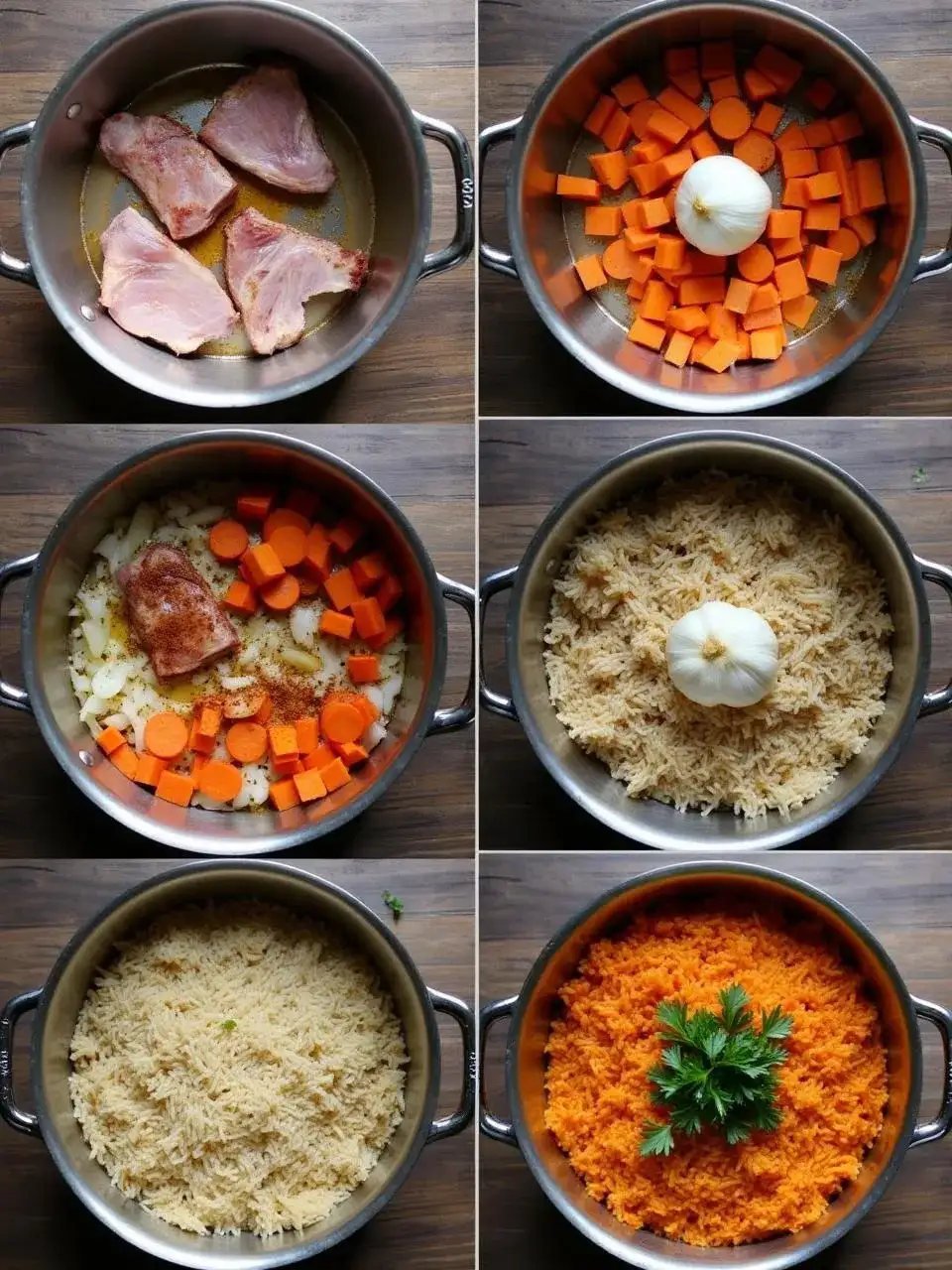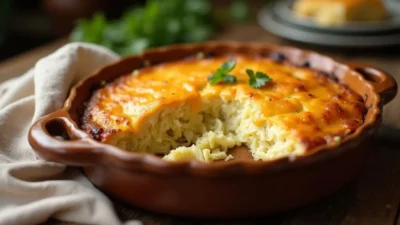Contents
A hearty and aromatic one-pot rice dish inspired by Uzbek plov and beloved in Lithuanian kitchens. Made with tender pork, carrots, onions, and warm spices, this comforting pilaf is perfect for family gatherings, cozy dinners, or meal prep. Simple, budget-friendly, and packed with flavor.
Equipment
- Large heavy-bottomed pot with lid
- Sharp knife
- Cutting board
- Fine mesh sieve
Ingredients
- 3 tbsp neutral oil (sunflower, canola, or rapeseed)
- 500 g (1.1 lb) pork shoulder, pork neck, or pork loin, cut into chunks
- 1 large onion, finely chopped
- 1 large carrot, sliced into thin semi-circles
- ¼ tsp ground cumin
- ¼ tsp sweet paprika
- Salt and black pepper, to taste
- 1 small bulb garlic (whole, unpeeled, root end removed)
- 300 g (2¼ cups) long-grain rice (such as basmati)
- 600 ml (2.5 cups) hot water
Instructions
- Heat the oil in a heavy-bottomed pot over high heat. Add pork chunks and sear on all sides until browned. Remove from pot.
- Reduce heat to medium. Sauté chopped onions for 5–6 minutes until soft.
- Return pork to the pot, add carrots, and fry for another 10–12 minutes, stirring occasionally.
- Stir in cumin and paprika, cooking for 1 minute to release aroma.
- Pour just enough hot water to cover the meat and veggies. Simmer on low for 30–60 minutes (depending on the pork cut).
- Season with salt and pepper. Add whole garlic bulb (unpeeled).
- Rinse rice thoroughly under cold water to remove starch. Spread evenly over the meat.
- Carefully pour 600 ml hot water over the rice. Bring to a boil, then reduce to the lowest heat and simmer uncovered for 10 minutes.
- Cover with a lid and simmer another 15–20 minutes. If rice isn’t tender, add more water and cook slightly longer.
- Remove garlic bulb, fluff the rice, garnish with parsley, and serve hot.
Notes
 A Comforting, Aromatic Rice Dish Loved Across Lithuania
Lithuanian cuisine has a wonderful way of adopting beloved international dishes and giving them a homey, local twist. One such treasure is Pork Pilaf, or Kiaulienos Plovas — a flavorful, satisfying rice dish inspired by Central Asian plov but made uniquely Lithuanian with tender pork and humble, pantry-friendly ingredients.
This dish is the definition of comfort food—a one-pot meal that’s easy to prepare, deeply aromatic, and perfect for feeding a hungry crowd. Whether it's for a cozy weeknight dinner, a family celebration, or a potluck, pork pilaf never fails to impress with its rich taste and rustic charm.
A Comforting, Aromatic Rice Dish Loved Across Lithuania
Lithuanian cuisine has a wonderful way of adopting beloved international dishes and giving them a homey, local twist. One such treasure is Pork Pilaf, or Kiaulienos Plovas — a flavorful, satisfying rice dish inspired by Central Asian plov but made uniquely Lithuanian with tender pork and humble, pantry-friendly ingredients.
This dish is the definition of comfort food—a one-pot meal that’s easy to prepare, deeply aromatic, and perfect for feeding a hungry crowd. Whether it's for a cozy weeknight dinner, a family celebration, or a potluck, pork pilaf never fails to impress with its rich taste and rustic charm.🌍 What Is Pilaf or Plov?
Plov, known globally as pilaf, is a fragrant rice dish that originated in Uzbekistan, eventually spreading across Central Asia, Eastern Europe, and even India. The essence of a good plov lies in the perfectly cooked, fluffy rice, harmonized with meat, vegetables, and warm spices. In ancient Persia, rice pilaf was served at royal feasts, a dish symbolizing generosity and hospitality. A famous Uzbek saying reflects its universal appeal:“If you're poor, you eat plov. If you're rich, you eat plov exclusively.”
🇱🇹 Plovas in Lithuanian Kitchens
In Lithuania, this dish has been wholeheartedly embraced as plovas and adapted to local preferences. Instead of the traditional lamb, pork is the protein of choice here—affordable, accessible, and delicious. Sometimes chicken is used as well. Lithuanian-style pork pilaf is simple but satisfying, made with everyday ingredients and a whole lot of love. It’s a dish that brings people together—especially during large gatherings, Sunday lunches, or spontaneous family visits. For many Lithuanians, plovas is more than food—it's a memory. One could almost smell the garlicky aroma filling the kitchen, with curious little fingers sneaking spoonfuls from the pot before it’s ready. 😄🛒 Ingredients You’ll Need
Here’s what goes into this comforting one-pot wonder:- 3 tbsp neutral oil (e.g., sunflower, canola, rapeseed)
- 500 g (1.1 lb) pork (shoulder, neck, or for leaner options, loin/tenderloin)
- 1 large onion, finely chopped
- 1 large carrot, sliced into thin semi-circles
- ¼ tsp ground cumin
- ¼ tsp sweet paprika
- Salt & freshly ground black pepper, to taste
- 1 small garlic bulb, whole, unpeeled (cut the root end off)
- 300 g (2¼ cups) long-grain rice (like basmati)
- 600 ml (2.5 cups) hot water
- Tomato paste or ketchup (see below for the great debate!)
- Ground coriander, turmeric, dried barberries, or cayenne pepper for extra flavor depth
🍅 The Great Lithuanian Tomato Debate
Many Lithuanians remember their pork pilaf having a subtle tomato tang, usually from tomato paste or—controversially—ketchup! While some argue this version hails from Soviet-era school canteens, others consider it an authentic comfort twist. Whether you choose to include a spoonful of tomato paste or not, it’s entirely up to you—and your family traditions.👨🍳 Step-by-Step Cooking Instructions
1. Sear the Pork
Heat oil in a large, heavy-bottomed pot over high heat. Add pork chunks and brown them well on all sides. This adds deep flavor. Remove the meat and reduce heat to medium-low.2. Sauté the Vegetables
Add chopped onion and cook for 5–6 minutes until softened. Return the pork to the pot and add carrots. Cook for another 10–12 minutes, stirring frequently.3. Spice it Up
Stir in cumin and paprika, letting the spices bloom for about 1 minute.4. Simmer the Base
Pour in just enough hot water to barely cover the pork and veggies. Simmer gently, uncovered, for 30–60 minutes, depending on your cut of pork:- Tenderloin: 30–40 minutes
- Pork shoulder/neck: 50–60 minutes
5. Season and Add Garlic
Season with salt and pepper. Nestle the whole bulb of garlic into the mixture—this infuses the dish with a subtle, earthy depth.6. Prepare the Rice
Rinse rice thoroughly in cold water until the water runs clear. This step removes excess starch and helps the grains stay fluffy.7. Layer and Cook the Rice
Spread the rinsed rice in an even layer over the meat. Gently pour 600 ml (2.5 cups) of hot water over it. Bring to a boil, then reduce heat to low and simmer without a lid for 10 minutes.8. Steam It
Cover the pot tightly and simmer for another 15–20 minutes. If rice is still firm when the water is absorbed, add a splash more water and simmer a few more minutes.9. Serve and Garnish
Fluff the pilaf gently, remove the garlic bulb, and serve hot. Garnish with chopped parsley, chili flakes, or even roasted garlic if desired 🌿🌶️.🍚 Recipe Tips for Perfect Pork Pilaf
✅ Use Long-Grain RiceStick with basmati or other long-grain white rice. Avoid sticky rice types like risotto or sushi rice.
✅ Rinse the Rice Well
This is key to achieving non-clumpy, fluffy rice.
✅ Cut Pork Smartly
Larger chunks for lean cuts (to retain juiciness), smaller bits for fatty cuts (to render better).
✅ Spice It Your Way
Feel free to add your own flair with spices like coriander, cinnamon, turmeric, or even dried fruit like barberries or raisins.
🥗 What to Serve with Pork Pilaf
This dish is a complete meal on its own, but a simple side salad can brighten the plate. Try:- Cucumber and tomato salad with a light vinaigrette
- Steamed green beans with lemon
- A dollop of plain yogurt or sour cream
🧊 Storage & Reheating
Leftovers? No problem! Pork plov keeps well for up to 4 days in the fridge. Reheat in the microwave or on the stovetop with a splash of water or broth. 🛑 Tip: Be cautious not to overcook during reheating—rice can become mushy if overheated.🍳 Equipment You'll Need
- Heavy-bottomed pot with a lid
- Sharp knife and cutting board
- Fine-mesh sieve for rinsing rice
Let this traditional Lithuanian pork pilaf bring a touch of nostalgia and warmth to your kitchen. With its fragrant spices, tender meat, and comforting rice, it’s a recipe that never fails to bring people together around the table. 💛🍴






Ooh, this looks amazing! A Lithuanian twist on plov – I’m totally intrigued! That pork shoulder sounds like it would get so tender and flavorful in all those spices. Definitely adding this to my “to-cook” list for a cozy weekend meal. Thanks for sharing!